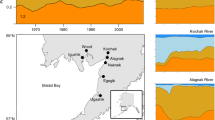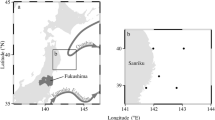Abstract
Chinook salmon (Oncorhynchus tshawytscha) reproduce only once in their lifetime, and their age at reproduction varies among individuals (indeterminate semelparous). However, the factors that determine their spawning age still remain uncertain. Evidence from recent studies suggests that individual growth and reproduction of Chinook salmon are affected by the rate of coastal upwelling, which is shown to be positively autocorrelated between years. Therefore, the serially autocorrelated environmental is expected to play an important role in determining their spawning age. In the present study, I demonstrate the advantage of an indeterminate maturation strategy under a stochastic environment. I then present theoretical evidence for the advantage of adjusting the maturation probability based on the environment they experienced and demonstrate that fisheries reduce the fitness of the strategy to delay maturation. The results presented herein emphasize the importance of incorporating detailed life-history strategies of organisms when undertaking population management.








Similar content being viewed by others
References
Botsford LW, Lawrence CA (2002) Patterns of co-variability among California Current Chinook salmon, coho salmon, Dungeness crab, and physical oceanographic conditions. Prog Oceanogr 53:283–305
Caswell H (2001) Matrix population models: construction, analysis and interpretation, 2nd edn. Sinauer Associates, Sunderland, MA, USA
Coulson T, Catchpole EA, Albon SD, Morgan BJT, Pemberton JM, Clutton-Brock TH, Crawley MJ, Grenfell BT (2001) Age, sex, density, winter weather, and population crashes in Soay sheep. Science 292:1528–1531
Fujiwara M, Caswell H (2001) Demography of the endangered North Atlantic right whale. Nature 414:537–541
Fujiwara M, Kendall BE, Nisbet RM (2004) Growth autocorrelation and animal size variation. Ecol Lett 7:106–113
Fujiwara M, Mohr MS (2007) Effects of environmental factors on fall-run chinook salmon (Oncorhynchus tshawytscha) within the Klamath Basin. (in press)
Gallager RG (1995) Discrete stochastic processes. Kluwer Academic Publishers, Boston, MA, USA
Gargett AE (1997) The optimal stability ‘window’: a mechanism underlying decadal fluctuations in North Pacific salmon stocks? Fisheries Oceanogr 6:109–117
Greene CM, Beechie TJ (2004) Consequences of potential density-dependent mechanisms on recovery of ocean-type chinook salmon (Oncorhynchus tshawytscha). Can J Fish Aquat Sci 61:590–602
Gurney WSC, Middleton DAJ (1996) Optimal resource allocation in a randomly varying environment. Funct Ecol 10:602–612
Hallett TB, Coulson T, Pilkington JG, Clutton-Brock TH, Pemberton JM, Grenfell BT (2004) Why large-scale climate indices seem to predict ecological processes better than local weather. Nature 430:71–75
Hankin DG, Healey MC (1986) Dependence of exploitation rates for maximum yield and stock collapse on age and sex structure of Chinook salmon (Oncorhynchus tshawytscha) stocks. Can J Fish Aquat Sci 43:1746–1759
Hankin DG, McKelvey R (1985) Comment on fecundity of Chinook salmon and its relevance to life-history theory. Can J Fish Aquat Sci 42:393–394
Hankin DG, Nicholas JW, Downey TW (1993) Evidence for inheritance of age of maturity in Chinook salmon (Oncorhynchus tshawytscha). Can J Fish Aquat Sci 50:343–358
Hare SR, Mantua NJ, Francis RC (1999) Inverse production regimes: Alaska and West Coast Pacific salmon. Fisheries 24:6–14
Healey MC (1991) Life history of Chinook salmon (Oncorhynchus tshawytscha). In: Groot C, Margolis L (eds) Pacific Salmon: life histories. UBS Press, Vancouver, British Columbia, Canada
Healey MC, Heard WR (1984) Inter-population and intra-population variation in the fecundity of Chinook salmon (Oncorhynchus tshawytscha) and its relevance to life-history theory. Can J Fish Aquat Sci 41:476–483
Heino M (1998) Management of evolving fish stocks. Can J Fish Aquat Sci 55:1971–1982
Heino M, Dieckmann U, Godo OR (2002a) Estimating reaction norms for age and size at maturation with reconstructed immature size distributions: a new technique illustrated by application to Northeast Arctic cod. ICES J Mar Sci 59:562–575
Heino M, Dieckmann U, Godo OR (2002b) Measuring probabilistic reaction norms for age and size at maturation. Evolution 56:669–678
Hill MF, Botsford LW, Hastings A (2003) The effects of spawning age distribution on salmon persistence in fluctuating environments. J Anim Ecol 72:736–744
Jonsson N, Jonsson B, Hansen LP (2003) The marine survival and growth of wild and hatchery-reared Atlantic salmon. J Appl Ecol 40:900–911
Kaitala V, Getz WM (1995) Population dynamics and harvesting of semelparous specie with phenotypic and genotypic variability in reproductive age. J Math Biol 33:521–556
Kingsolver JG, Massie KR, Shlichta JG, Smith MH, Ragland GJ, Gomulkiewicz R (2007) Relating environmental variation to selection on reaction norms: an experimental test. Am Nat 169:163–174
Law R (2000) Fishing, selection, and phenotypic evolution. ICES J Mar Sci 57:659–669
Mantua NJ, Hare SR (2002) The Pacific decadal oscillation. J Oceanogr 58:35–44
Mantua NJ, Hare SR, Zhang Y, Wallace JM, Francis RC (1997) A Pacific interdecadal climate oscillation with impacts on salmon production. Bull Am Meteorol Soc 78:1069–1079
McGregor EA (1922) Observations on the egg yield of Klamath River king salmon. Calif Fish Game Report 8:161–164
Morita K, Fukuwaka MA (2006) Does size matter most? The effect of growth history on probabilistic reaction norm for salmon maturation. Evolution 60:1516–1521
Morita K, Morita SH, Fukuwaka M, Matsuda H (2005) Rule of age and size at maturity of chum salmon (Oncorhynchus keta): implications of recent trends among Oncorhynchus spp. Can J Fish Aquat Sci 62:2752–2759
Prager MH, Mohr MS (2001) The harvest rate model for Klamath river fall Chinook salmon, with management applications and comments on model development and documentation. North Am J Fish Manage 21:533–547
Quinn TP (2005) The behavior and ecology of Pacific salmon & Trout. University of Washington Press, Seattle, WA, USA
Ricker WE (1958) Handbook of computations for biological statistics of fish populations. The Fisheries Research Board of Canada, Ottawa, Canada
Ricker WE (1981) Changes in the average size and average age of Pacific salmon. Can J Fish Aquat Sci 38:1636–1656
Scheuerell MD, Williams JG (2005) Forecasting climate-induced changes in the survival of Snake River spring/summer Chinook salmon (Oncorhynchus tshawytscha). Fisheries Oceanogr 14:448–457
Tuljapurkar S, Haridas CV (2006) Temporal autocorrelation and stochastic population growth. Ecol Lett 9:327–337
Wells BK, Grimes CB, Waldvogel JB (2007) Quantifying the effects of wind, upwelling, curl, sea surface temperature, and sea level height on growth and maturation of a California Chinook salmon (Oncorhynchus tshawytscha) population. Fisheries Oceanogr 16:363–382
Wilmers CC, Post E, Hastings A (2007) A perfect storm: the combined effects on population fluctuations of autocorrelated environmental noise, age structure, and density dependence. Am Nat 169:673–683
Acknowledgement
I thank Michael Mohr, Eric Bjorkstedt, and two anonymous reviewers for constructive comments on the manuscript and Marc Mangel for comments at the initial stage of this study. I also extend a special thanks to Morgan Knechtle at the California Department of Fish and Game for providing me with his preliminary result related to the maturation rate of Chinook salmon.
Author information
Authors and Affiliations
Corresponding author
Appendix
Appendix
Appendix A
Environmental indices and associated correlograms. a Monthly Coastal Upwelling Index (CUI) in June at 42°N 125°W (http://swfsc.noaa.gov/) and b associated Correlogram. c Winter (December, January, February, and March) Pacific Decadal Oscillation (PDO) index (http://www.jisao.washington.edu/pdo/) and d associated correlogram. e Winter North Atlantic Oscillation (NAO) index (http://www.cgd.ucar.edu/cas/jhurrell/nao.stat.winter.html) and f associated correlogram. The lag_one autocorrelations of all three indices are significantly positive (p ≈ 0.0002 for CUI; p ≈ 0.0076 for PDO index; p ≈ 0.0412 for NAO index)
Appendix B
This appendix describes the derivation of Eqs. 1–(2). First, let n 1,t + 1 the number of individuals in Stage 1 at time t + 1. Then, the expected number of individuals in Stage 1 at time t + 1, conditional on the fact that their parents experienced a favorable environment immediately before their reproduction (X t = 1), is given by
where E(·) denotes the expectation of the argument and p is the probability that the environment at time t-1 was also favorable, as the environmental model is reversible (see Gallager 1995). Refer to Table 2 for the specifications of \( F^{{{\left( \cdot \right)}}}_{k} \). Expressing n i,t in terms of the number of individuals in Stage 2, Eq. B1 becomes
Refer to Tables 1 and 2 for descriptions of the parameters in Eq. B2. Assuming a stable stage distribution, \( \alpha E{\left( {n_{{1,t + 1}} } \right)} = E{\left( {n_{{2,t - 1}} } \right)} = E{\left( {n_{{2,t - 2}} } \right)} \), where α is a constant relating to the number of individuals in stages 1 and 2. By dividing both sides by \( S_{r} S^{{{48} \mathord{\left/ {\vphantom {{48} {52}}} \right. \kern-\nulldelimiterspace} {52}}}_{0} {\text{E}}{\left( {n_{{2,t - 1}} } \right)} \) and equating it to E(\( {\Re }_{1} \)), we obtain,
where S 0 = 0.8 (Table 1). Similarly, we obtain Eq. 2 as
These quantities are the total number of offspring produced by Stage 3 and 4 divided by a quantity that is proportional to the number of individuals in Stage 2 (which is in turn proportional to the number of individuals in other stages under a stable stage distribution). Thus, E(\( {\Re }_{1} \)) and E(\( {\Re }_{0} \)) are indices of the fertilities assuming a stable stage distribution.
Rights and permissions
About this article
Cite this article
Fujiwara, M. Effects of an autocorrelated stochastic environment and fisheries on the age at maturity of Chinook salmon. Theor Ecol 1, 89–101 (2008). https://doi.org/10.1007/s12080-007-0008-7
Received:
Accepted:
Published:
Issue Date:
DOI: https://doi.org/10.1007/s12080-007-0008-7





